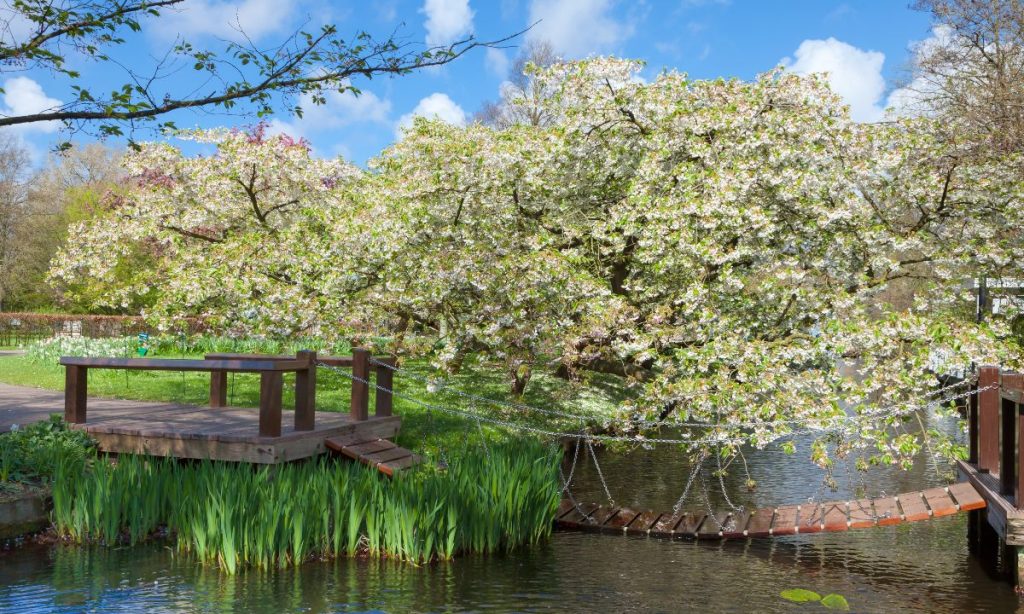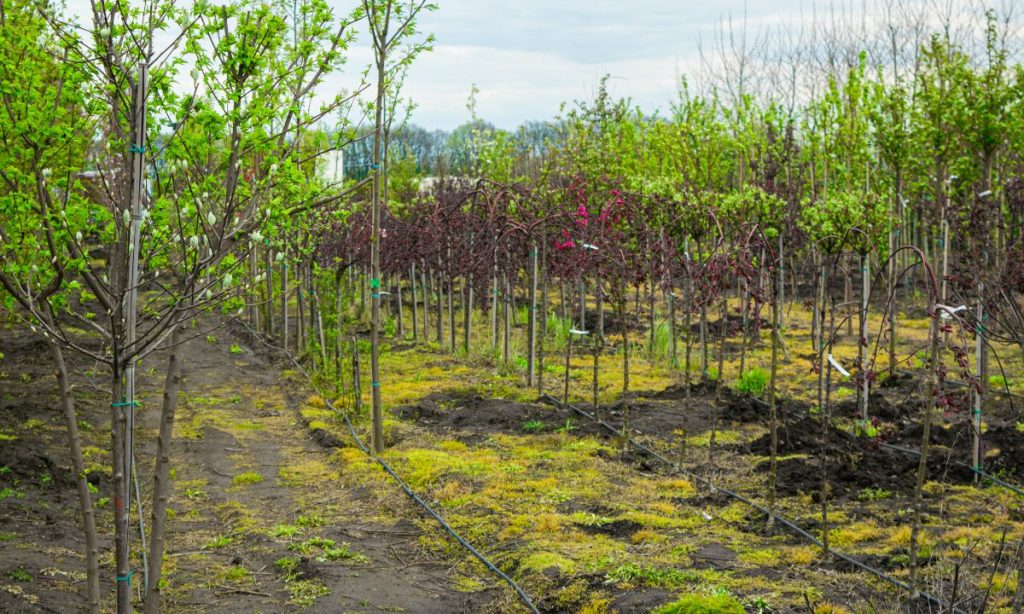If you’ve already gained some experience growing plants for profit and are ready to foray into the world of woody ornamentals, there is some serious money to be made.
Keep reading to learn all about this unique profit opportunity.
What are Woody Ornamental Plants?
Woody ornamental plants are trees and shrubs that are grown for their aesthetic appeal rather than their economic value.
They’re popular among homeowners who are interested in creating an attractive outdoor space for their backyards.
If you’re looking to add some lush, green beauty to your landscape, woody ornamentals may be the perfect choice.
Not only are they low-maintenance, but many of them also make excellent garden plants.
Some of the most popular varieties of woody ornamentals are shade trees, fruit trees, evergreen shrubs and bushes, vines and ground covers.
They can be planted to create privacy or shade, to fill in bare spots in the garden, or to provide attractive decoration when placed around your garden bed or along your walkways.
Woody ornamentals are also particularly useful in areas where you need to grow plants that require a lot of water.
They can withstand dry conditions much better than herbaceous perennials and other flowering species.
However, they usually require less frequent watering than grasses and certain vegetables do, and they can tolerate drought better than many other types of plants.
Growing woody ornamental plants can be very profitable for gardeners who know how to properly care for their crops.
They require relatively little maintenance, making them an attractive option for gardeners with busy schedules.
Many varieties can also be grown outdoors year-round with minimal care. In addition to being profitable, growing woody ornamentals can be a great way to introduce more variety into your garden.
By selecting a variety of different types of trees, shrubs, vines, and ground covers, you can create a unique and attractive landscape design that will become the focal point of your (or your customer’s) yard.
If you’re interested in growing woody ornamental plants on your property, be sure to do your research before getting started.
Like any plant, they need to be cared for properly in order to reach their full potential.
With the right care and a little luck, growing woody ornamental plants can be a great source of income for gardeners who enjoy the natural beauty they provide to their surroundings.

Types of Woody Ornamentals
Here is a list of some of the most common types of woody ornamental plants that you can grow for profit:
Trees: apple, cherry, pear, oak, hickory, beech, birch, maple, spruce, sycamore, willow, black locust, ash
Vines: grapes, kiwis, hops, blackberries, raspberries, kiwi berries, etc.
Ground covers: jasmine, junipers, hostas, coleus, geraniums, azaleas, camellias, rhododendrons, hardy fuchsias, primroses, daylilies, phloxes, tulips, pansies, bleeding hearts, impatiens, petunias,
Shrubs: barberry, mock orange, viburnum, rose of Sharon, Japanese maple, lilac, dogwood, butterfly bush, redbud, crabapple, holly
How Much Money Can You Make Growing Woody Ornamentals?
As with most garden crops, the amount you earn growing woody ornamentals will vary depending on factors such as how much land you have available and the time of year you plant your crop.
As a general rule, most varieties of trees and shrubs will yield about $100-$200 per acre per year.
Larger varieties like apples and walnuts can yield up to $500 or more per acre per year.
If you’re just getting started or don’t have much experience with growing these types of plants, you can usually expect to earn around $50-$100 per acre per year.
However, with more experience and increased knowledge of successful gardening techniques, you can easily increase your earnings by as much as 25% or more each year.

Tips for Successfully Growing Woody Ornamentals
Most commercial growers breed plants to grow quickly and cheaply to maximize profits.
These plants are often bred to withstand disease and pest infestations, which allows them to be shipped long distances without succumbing to infection.
Growers also breed the plants to have large flowers or fruits.
This approach to breeding often results in plants that produce an inferior quality of fruit and flower when compared to naturally occurring varieties.
If you’re looking for high-quality fruits and flowers, you should seek out naturally-grown varieties from your local nursery rather than buying artificially-bred specimens from catalogs or online gardening stores.
Whether you’re a beginning gardener looking for an easy way to earn some extra money or a more experienced gardener who’s looking to expand their landscape business, there are a wide variety of ways to grow and market your woody ornamental plants for profit.
Here are a few tips to help you get started:
Before you decide whether or not you’re going to grow a particular type of plant, it’s important to familiarize yourself with the factors that will affect its success in the garden.
Different species of plants have different requirements for light and water, so be sure to find out how much direct sunlight the plant needs and the humidity level it requires for optimal growth.
You should also do some research into common pests and diseases that can affect the plants in your area so that you’ll be prepared to deal with any problems that arise during the growing season.
Once you’ve taken care of these preparations, you can move on to the fun part: actually planting and growing your plants!
Growing woody ornamental plants can be a rewarding and profitable experience if you’re willing to make the effort to properly prepare them for the growing season.
Ensure that you purchase plants that will grow well in your climate and climate zone.
It’s also a good idea to check your local zoning laws before you start selling your plants to ensure that they comply with any regulations governing the sale of plants and seeds in your area.
Finally, read the product labels on your plants to determine whether or not they’ve been genetically modified or otherwise treated to improve their growth and productivity.

How to Market and Sell Your Woody Ornamentals
Once you’re ready to start selling your plants, you can either sell them directly from your garden or work with landscapers or nurseries.
If you’re looking to break into the landscaping business, you can also offer to design and build a residential or commercial garden for your customers or clients.
To learn more about how to get started in the business, you may want to attend horticultural classes at your local community college or look into online courses that can help you master the art of gardening.
While the profitability of your woody ornamental garden will depend on the size of your operation and how you choose to sell it, you can easily make several hundred dollars or more per season by selling your plants to a local nursery or landscaping company.
Depending on how many trees or shrubs you can sell to them at wholesale prices, you may be able to generate a good income by establishing a supply line for their needs.
Alternately, you could sell directly to homeowners who might be interested in planting a small collection of woody ornamentals in their yards.
The best way to determine how much money you can make by selling your plants is to research the local real estate market in your area and determine whether the demand for trees and shrubs is currently high enough to justify an investment in a commercial nursery or landscaping company.
You may also want to conduct some market research in your local area to determine whether there are enough potential customers in the area to support your own nursery.
It’s important to keep in mind that while it’s fairly easy to start your own nursery from scratch, it may take several years before you can generate a high enough sales volume to make a profit from your plant sales.
In addition, you’ll need to be prepared to invest in specialized tools and equipment in order to propagate and grow the plants that you want to sell or trade with other nurseries and landscapers.
Finally, you’ll need to have a good understanding of the local soil and weather conditions in your area so you can properly care for the plants that you grow.
Final Thoughts
Growing and selling woody ornamentals can be an excellent way to supplement your income.
It will most likely require that you work with local nurseries and landscapers, rather than growing plants individually and selling them at a farmer’s market.
A successful woody ornamental business can take years to become lucrative, so be patient, care consistently for your plants and trust the process.
Want to learn more about growing plants for a profit? Check out our Homesteading Hub.
